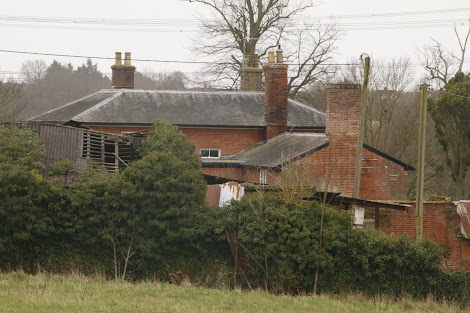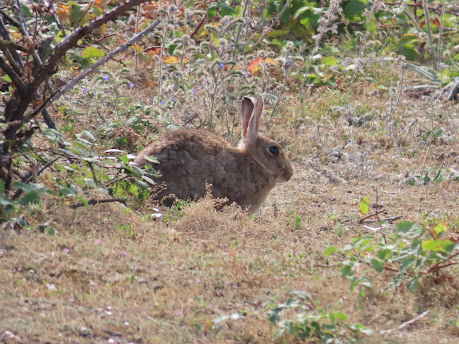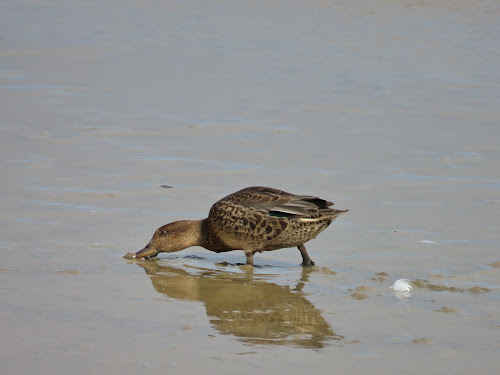What a strange year its been so far. Are we experiencing the start of climate change, a full on assault of uncontrollable weather patterns which will end up in the destruction of the planet. Or are is this just a blip in an otherwise normal stable planetary system. Maybe we'll look back on this time as a natural wonderland before our countryside dies off from climate change and unregulated industrial farming of our land.
Being a place I have visited for over eight years, I have felt this weather anomaly most on the Patch, a series of agricultural and equestrian fields with accompanying hedgerows and trees. The Patch is situated right on the border of North-west Ipswich, just outside of Whitton. Its good walking country with a range of footpaths well trodden by the feet of the many people that live nearby. There's not a main road in sight, something rare in this countryside, especially so close to urban areas. However, despite this, the Patch is not great birding country, as it is mainly agricultural land, with few woods or wetlands. This absence of variety in habitats means I don't really see much in the area, just the usual birds of the countryside.
The Patch is my local patch (obviously) a term used by birders to denote the area they watch on their doorstep. It doesn't matter that there is little bird life, because despite this lack, the few birds I do see feeds into its rich history. And being so close to where I live I can visit it any time, all I have to do is walk down the street and I can access as little or as much as I want of it. In the eight years I have lived in Whitton I have visited the Patch so many times that I know it like the back of my hand. From my garden, I often hear skylarks singing from the nearby fields or have buzzards fly over.
Unfortunately having to work more hours at my current job, I have had less time to spend on The Patch, recently, and as a result have not been able to get out there to much extent. With so little time spent here I have decided to meld together the two seasons of Spring and Summer into this one blog.
Since I last wrote about the Patch, mid-March, many things have happened in the world. Most obvious of all has been the end of the third lockdown, which this time (hopefully) is an end for good. This has resulted in the world opening up, giving me so much options for birding, and as a result less need to visit the Patch.
The Patch starts from Old Norwich Road, a nice quiet, rural street which has been restricted to cars, to avoid being a rat run down to Claydon, and as a result is a haven for cyclists and joggers, and walkers like myself. A small way along the road, there is a paddock where horse's graze amongst thick scrub, just before the path leaves the road for the main part of the Patch. Here a cock PHEASANT lords it over his harem of five females; this is the only place where this bird can be found on the Patch, as there is no shooting in the area no birds have been introduced and they exist here entirely naturally in small numbers.
With early Spring in the air, March ended, strangely enough, with record temperatures for that month, as we were hit by heat haze, leading a lot of people to believe that we were in for a hot Spring and Summer; we weren't. The BUZZARDS started to establish their territory on the Suffolk Punch Field, one bird is resident throughout the year with another bird joining it for the breeding season. The YELLOWHAMMERS started singing, joining the already advanced SKYLARKS, who had begun in February. Yellowhammers, although not common are present in decent numbers, and are one of the key farmland birds on the Patch, their song calling out for a "little bread and no cheese".
Then, from April the weather became unusual. On the 5/4 we had snow, a harbinger for what April would be. Frosts were common and the frozen ground continued into early May, far longer than it should do. And then there was the rain, or lack there of. For six weeks, including all of April, it didn't rain. Water levels fell and nothing grew, and there was a real possibility of ecosystem collapse caused by it.
The footpath to the Patch leads off from Old Norwich Road, through First Field, an area of exhausted agricultural land allowed to become fallow, that has become overgrown with grasses and flowers. It is amazing how in a couple of years this fallow field has been colonised so readily by flowers. This is most readily shown by its huge colony of PYRAMMID ORCHIDS seen here. The spikes of this lovely purple flower grow amongst the tall grasses, and this year I recorded over 1,100 spikes, which is an amazing total, up from a couple of hundred last year. To think this area is not a nature reserve, nor in anyway managed for its orchids, which makes it quite remarkable there were so many present. Nowhere have I seen anything like this, I always assumed orchids were the occupants of ancient grasslands that have survived that way since the dark ages, not ex arable land that was sprayed and under the plough only a few years ago. And this was all in one small corner of the field, imagine what it could be like if the flower was able to spread across the whole of the land. It just proves how important set-a-side is in our farmed landscape.
Around the Patch there are areas of rough grassland, those little unkempt pockets where management isn't needed, and this is where you find BUTTERFLIES, though never in large numbers. The brilliant March weather encouraged them to come out early, starting with PEACOCKS on 24/3, followed by BRIMSTONE and SMALL TORTOISESHELL a week later, with MEADOW BROWNS coming out a bit later on with SKIPPERS and BLUES and WHITES flying around as well.
On 6/4 the first BLACKCAP of the year began to sing, at an early date for this species here. This was from Rede Wood, the only area of woodland on the Patch. Ancient woodland is an extremely important habitat, a haven for more wildlife than the surrounding farmland. Being small and so isolated it doesn't have many specialised woodland birds, but acts as an important home for wildlife in a sea of intensive arable land. Around four BLACKCAPS were singing here, as well as drumming GREAT SPOTTED WOODPECKER and a second pair of BUZZARD were on territory here.
Rede Wood doesn't have any old trees, but has been woodland as far back as records go. It has a thick understory of young trees and brambles, a sign of a healthy ecosystem, but results in there being none of the big floral displays. Flowers mostly grew around the edges in areas where light can get through the canopy, and flowers included the typical PRIMROSE, DOG'S MERCURY and WOOD ANAMONE found in such woodlands. Rede Wood is hard to get to, a couple of miles of walking, its accessible by road but there's no parking, so I don't get up there enough. Its just the fact that there are more places to explore than there is the time to do it.
I didn't visit the Patch for a lot of April so I missed all the comings and goings, and specifically the first summer arrivals which make birding at this time so interesting, when a bird is first seen in the area, which you can compare over the years. Chiffchaffs first, followed by blackcaps, and then by whitethroats and lesser whitethroats is the usual order of things.
In the beginning of May the First Field was carpeted in DANDELIONS. creating a sea of yellow on that land. Later on, in June It would stay yellow, but his time carpeted with HAWKWEED, a slightly taller flower, and then into July it would stay yellow again, this time created by RAGWORTS, an even taller flower. Three different shades of yellow at three different dates in the year, its a testament to how much leaving land to set aside can be so important in a landscape that is so intensively farmed.
And then on 8/5 we had rain, finally. From then on May would be a soggy inundated month more than making up for the dry April weather. There was little sun, no harbingers of a warm summer, just grey clouds. June would be the same, grey and rainy, and whilst July added some sun, it wasn't the usual summer weather. But with all the rain things grew and the countryside was lush and verdant, an exquisite green in colour.
On 7/5 LESSER WHITETHROATS were singing from the First Field hedge, whilst COMMON WHITETHROATS had returned to the usual haunts. There is an area of hedgerow where a whitethroat in one form or other has been on territory every year for eight years. Its amazing to think this bird or its subsequent generations have been able to hone in on one area every time, every year, returning from Africa, that such a tiny bird can do such things entirely by instinct is absolutely amazing.
Second Field had been planted with rape this year, and as a result was a vivid yellow for most of May and June. From Second Field, the footpath traverses River Meadow, a hay meadow, with the Stream, a small drainage ditch which cuts through it. Waterlevels undulate here, drying out this April, whilst filling up with May's rains. From there its a short walk up to Suffolk Punch Field, where the path connects to a cross roads.
Suffolk Punch Field is an area of permanent grassland with scattered bushes, and a small area of woodland where the local BUZZARDS nest. It is probably the best area on the Patch for birds, particularly Autumn migrants which like the bushes. In this area the footpath networks turns into a spider's web, as paths go everywhere. The entrance to the Field is guarded by a large dead tree, a sentinel of the Patch, a hole in which encourages a pair of BLUE TITS to nest.
The Suffolk Punch Field is good for wintering THRUSHES. Towards the end of March the last of them passed through with a flock of 50 REDWINGS regular, with the final spot, of four FIELDFARES on 2/4. Small flocks of MEADOW PIPIT passed through, as well as flocks of WOOD PIGEON.
Taking the north path leads to the Prairie Field a big expanse of arable land, the sort of landscape that dominates the area beyond. This is a good site for HARES, but its lack of hedgerows and being large empty arable makes it poor for birds. Usually I head east to Rise Hall across the Suffolk Punch Field. At the other end of the Field, just before Rise Hall is the Pond, a small bit of water, surrounded by tall trees. It used to have a resident flock of GREYLAG GEESE, but they have seemed to have disappeared recently. Here, and in the tall trees by the Hall is a good spot for GREAT SPOTTED WOODPECKER, with one usually heard drumming here, the sound resonating across The Patch.
By Rise Hall, the the route I took passes the Reservoir, which with the Pond is the only wetland on the Patch. A small manmade pool surrounded by trees, sometimes you get the odd wetland bird, but not during this period. SWALLOWS that nest in the abandoned farm buildings by the Hall hawk over here for insects. The water is clear and CARP occasionally break the surface of the water. The chance of catching one of those fish encourages local scallywags to fish here. The landowner is always on the lookout for illegal fishermen, he often accosts me when he sees me standing by the water, and I have to explain I am only looking for birds.
Akenham Church is a lonely old building, unused, it sits atop the high ground keeping vigil over the rest of The Patch. Just up from the Reservoir I often take a rest here, sitting on one of the flat tombstones in its grassy yard. Occasionally a ROBIN will perch on a gravestone, enticing me with its pose. Past the church there are more equestrian fields, until we get to Lark Field. This is a big prairie field of monoculture, with some crop or other, on the downside of a hill. It has the bonus of being the best place for SKYLARKS on the Patch. We're not talking large numbers but there are usually flocks of this birds here in winter and plenty of singing birds in Summer. This is a bird that still manages to do fairly well in the local area, but is a bird in decline in the country as a whole.
From Lark Field I usually head back through some more agricultural land, heading along minor roads, free of traffic. The last area of note is the field behind the sport's centre. This starts at the base of a small hill where some horse fields merge into thick scrub and woodland, nice non intensively used land, sort of what old farms used to look like a long time ago. On the 11/6 I inadvertently disturbed a FOX, slinking though the long grass, he was surprised to see me, although being on the edge of an urban area should have been more used to humans. As I walk up the hill so the signs of civilisation become more prevalent, the countryside peters out and houses, gardens and roads take the place of the the wild. The Patch is now a memory I keep with myself, to last me through the human world, until I can get out again into the countryside.
Every bird watcher has a local patch, a special place all of their own and The Patch is very much my own space. Sure I share it with dog walkers and horse riders, but I have not seen any other birdwatchers here. And yes, there is little surprise bird wise here, but this is the place where I can access nature, where I can wash off the stink of urban life, come back to some long suppressed inner need to escape civilisation, to be back in the wild. And that's why this very average place is so very special to me.


























































